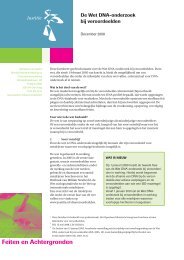INTERPOL HANDBOOK ON DNA DATA EXCHANGE AND PRACTICE
INTERPOL HANDBOOK ON DNA DATA EXCHANGE AND PRACTICE
INTERPOL HANDBOOK ON DNA DATA EXCHANGE AND PRACTICE
Create successful ePaper yourself
Turn your PDF publications into a flip-book with our unique Google optimized e-Paper software.
to interpret the more complex results generated from crime scene samples, such asmixtures. However scientists are still required to review and validate the interpretationbefore it can be officially accepted. The latest advances in these kinds of softwaresystems have made them more sophisticated in terms of the rules they apply to theresult, so that now only the occasional result is referred to the scientist for review.•measures to ensure confidenceLaboratories have to prove that they can consistently produce <strong>DNA</strong> profiles that arereliable. The forensic laboratories and the <strong>DNA</strong> Database in any country should beaccredited or be in compliance with standards such as the ISO Guide, ISO 17025 1in order to upload <strong>DNA</strong> profiles to national <strong>DNA</strong> Databases. Other standards canbe found on the CODIS website, the FBI Director’s Quality Assurance Standards forForensic & Database Laboratories 2 and the European Network of Forensic ScienceInstitutes (ENFSI) homepage 3 . These standards cover different factors that affect qualityincluding training and proficiency of personnel, the physical environment in which theanalysis is completed, the equipment and methods used, and the handling of items beinganalysed.Quality Assurance programmes such as European Network of Forensic ScienceInstitutes (ENSFI), International Laboratory Accreditation Co-operation (ILAC, UnitedKingdom), Australia’s National Association of Testing Authorities <strong>DNA</strong> Guidelines(NATA), R42-01 (South Africa), and National Standards issued by the Director of theFBI (United States) provide <strong>DNA</strong> guidelines directed towards ISO 17025.Accreditation can be achieved after an assessment has been conducted by an impartialagency which checks that a laboratory is in compliance with the necessary performancestandards. National accreditation bodies which conduct quality assurance audits exist inmany countries. Examples are the United Kingdom Accreditation Service (UKAS), Raadvoor Accreditatie (the Dutch Accreditation Council), the American Society of CrimeLaboratory Directors/Laboratory Accreditation Board (ASCLD/LAB), Forensic QualityServices (FQS) and the Swedish Board for Accreditation and Conformity Assessment(SWEDAC), Australia’s National Association of Testing Authorities (NATA), theAccreditation System for test laboratories and inspection bodies (BELTEST, Belgium),and the South African National Accreditation System (SANAS).Laboratories have to prove that they are continuing to meet the required standardsthrough a programme of internal and external quality audits. Furthermore, the courtsmust have confidence in the <strong>DNA</strong> results obtained by the laboratory, thereforelaboratories must ensure that these <strong>DNA</strong> results are accepted by adhering to theirquality programme.QUALITY ASSURANCE PAGE 43







